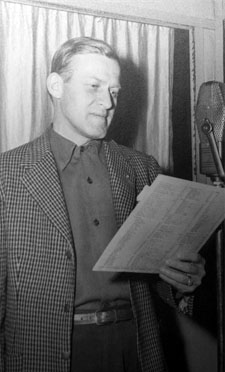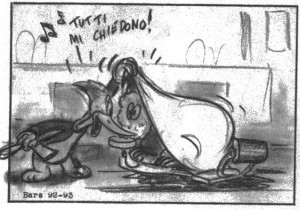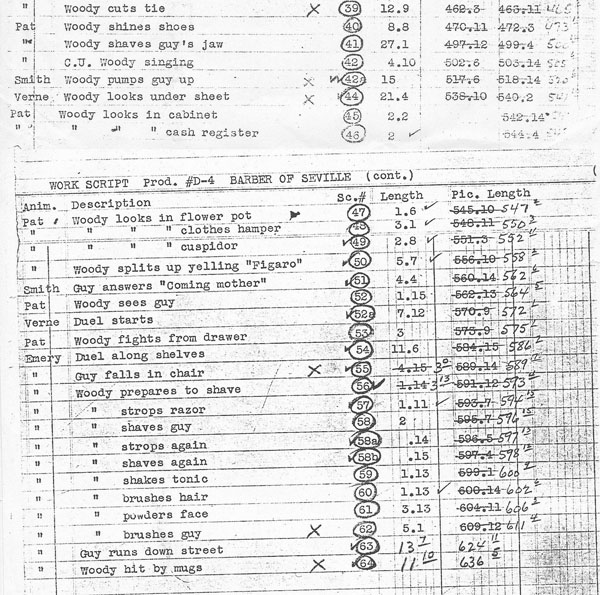Today’s Thanksgiving feature is Shamus Culhane’s first Woody Woodpecker!

It might be disappointing for some readers there aren’t any materials available for a Thanksgiving-related cartoon. It’d be nice if drafts of Chuck Jones’ Tom Turk and Daffy (1944), Tex Avery’s Jerky Turkey (1945), The Little Orphan (1949) with Tom and Jerry, or even Hugh Harman’s Tom Turkey and His Harmonica Humdingers (1940) to surface, but it just isn’t possible. (It might be very unlikely the documents for Holiday for Drumsticks, a 1949 Art Davis Daffy Duck, is extant either.)
Woody Woodpecker’s antics in a barbershop (or to a lesser extent, Woody’s insult remarking an Indian customer’s headdress) could slightly relate to those looking their sharpest, before they celebrate the sumptuous Thanksgiving repast with their loved ones. However, you will be happy to know this feature will incorporate a holiday theme during the month of December, starting next week, with cartoons related to Christmas or winter. Keep a sharp lookout!

In his autobiography, Talking Animals and Other People, Shamus Culhane recalled his captivation during film screenings at the American Contemporary Art in Hollywood while he started directing at Lantz. He witnessed the cinematic techniques of Russian filmmakers Sergei Eisenstein and V.I. Pudovkin, and influential figures such as D.W. Griffith, Fritz Lang and Jean Renoir. Culhane’s experience from the film screenings incited him to study Pudovkin’s Film Technique and Eisenstein’s Film Sense. The Barber of Seville proved to be a suitable project to make use of these methods.

Ben Hardaway
Culhane’s first handling of Woody was a most ambitious effort. It became the most expensive Lantz production in the 1943-44 release season, costing $16,717.
In this cartoon, Woody’s usual madness is justified – and hilariously overestimating in context – after being insulted by a burly, Italian hard-hat. The backgrounds for this sequence employ minimal visuals during most scenes, using solid or plain-color settings. The abstract nature works effectively to make the frenzied action readable, even if Woody doesn’t stand on firm ground as he shines the customer’s shoes in scene 40.
As the title indicates, Woody recites Gioachino Rossini’s “Largo al factotum” as he gives his customer “the whole works.” To provide Woody’s singing vocals, Lantz contacted Universal’s music director Joe Gershenson to find a trained singer whose singing would be mechanically sped up to match the woodpecker’s spoken voice.
The performing artist for Woody’s singing is provided by Lee Sweetland, who had dubbed the singing for actor George Dolenz (future Monkee Mickey Dolenz’s father) in a live-action feature. Sweetland’s normal singing voice can be heard in the opening of the Lantz Swing Symphony Sliphorn King of Polaroo, where he receives credit. It is uncertain, but the probable actor providing the voices for the two customers might be actor Nestor Paiva, known to have worked for Lantz. (As an added bonus, you can hear the normal pitch of Sweetland’s vocals in this audio-only clip.)
Pat Matthews animates Woody for the first time in Seville, portraying him as the most manic he had been so far in his animated career. Woody’s penetrating looks to the Italian customer, holding a razor blade underneath his nose (and slowly unsheathing it away from him) in scene 41, are frighteningly hysterical. Woody’s jump, accomplished with balletic grace, adds another stroke of brilliance. Matthews handles another great moment in the cartoon, with Woody searching and even splitting into multiple woodpeckers, calling out to his frightened customer. The reaction (scene 52) after he finds the customer and stretches out of the frame, exiting with his lower body, is pure lunacy.
 Verne Harding animates the start of the musical sequence in scene 34 with marvelous posing, as Woody lathers shaving cream on the Italian customer’s head. Harding handles a crucial escalation in tempo in scene 44, when Woody pops in various positions, lifting up the sheet and swinging the razor at his victim. Emery Hawkins is responsible for what Culhane anticipated in Seville – the rapid cutting as Woody finally keeps the Italian customer motionless. Frank Tashlin utilized this type of editing in animated cartoons in the mid-‘30s at Warners. Culhane knew the risks in this venture. With some shots lasting less than a second, there was a danger that the audience wouldn’t assimilate the material. However, as he stated in later years, “I felt just right speeding it up to keep the picture moving – it should take you on a roller-coaster ride, really give it to you.”
Verne Harding animates the start of the musical sequence in scene 34 with marvelous posing, as Woody lathers shaving cream on the Italian customer’s head. Harding handles a crucial escalation in tempo in scene 44, when Woody pops in various positions, lifting up the sheet and swinging the razor at his victim. Emery Hawkins is responsible for what Culhane anticipated in Seville – the rapid cutting as Woody finally keeps the Italian customer motionless. Frank Tashlin utilized this type of editing in animated cartoons in the mid-‘30s at Warners. Culhane knew the risks in this venture. With some shots lasting less than a second, there was a danger that the audience wouldn’t assimilate the material. However, as he stated in later years, “I felt just right speeding it up to keep the picture moving – it should take you on a roller-coaster ride, really give it to you.”

One particular weakness in this cartoon is the sequence with Woody and the Indian chief, which is burdened with Hardaway’s weak gags. The timing of the Indian receiving a “scalp treatment” in scene 20 is too quick, as if Culhane wants to end the sequence as succinctly as possible. This entire scene is credited to an artist named “Rudy,” presumably animator Rudy Zamora. Zamora was one of Culhane’s colleagues in the East Coast at Fleischer’s and over at Ub Iwerks’ studio when they moved West. He worked for Lantz in the mid-‘30s, but it’s uncertain if he animated for other Lantz cartoons in the 1940s. Another weakness that plagues Lantz cartoons from this period is the inconsistency in clean-up/inking in Les Kline’s scenes with Woody; his introductory scenes are nicely done, while shots of Woody in the barber chair are sloppy.
 When the pencil test for Seville was shown at the studio, Culhane claimed that the drawings were hard to interpret as line drawings. Lantz didn’t ask the director to modify the action, agreeing that it would be discernable after the drawings would be inked and painted. Ben Hardaway didn’t care for the fast cutting, and grumbled after the screening, “Looks like a Chinese goulash.” Culhane’s understanding of filmic techniques led to an enthusiastic response from the audience preview. To him, Seville remained “one of my most satisfying achievements as a director.”
When the pencil test for Seville was shown at the studio, Culhane claimed that the drawings were hard to interpret as line drawings. Lantz didn’t ask the director to modify the action, agreeing that it would be discernable after the drawings would be inked and painted. Ben Hardaway didn’t care for the fast cutting, and grumbled after the screening, “Looks like a Chinese goulash.” Culhane’s understanding of filmic techniques led to an enthusiastic response from the audience preview. To him, Seville remained “one of my most satisfying achievements as a director.”
Enjoy this breakdown video, and have a happy Thanksgiving!
(Note about the draft below: sc. 26A is credited to Kline, but the timing/posing is undeniably Hawkins, properly credited in the video above.)


(Thanks to Mark Kausler, Keith Scott, Frank Young, Michael Barrier and Joe Adamson for their help.)


 DEVON BAXTER is a film restoration artist, video editor, and animation researcher/writer currently residing in Pennsylvania. He also hosts a
DEVON BAXTER is a film restoration artist, video editor, and animation researcher/writer currently residing in Pennsylvania. He also hosts a 




















































































So, Lee Sweetland is doing the laugh at the end of the song? He does it quite well, actually.
Wonderfully funny cartoon. I have an original animation drawing from this cartoon, if I known about this posting it could have been used.
Anyone know why Ben Hardaway stopped voicing Woody?
http://www.patcartoons.blogspot.com/
To “Pat” Ventura:
I am trying to finish up a collection of interviews and articles I have done over the past 40 years of “Golden Age of Hollywood” arctors, technicians and animators. I was lucky enough to nervously interview Shamus Culhane when he was in Chicago for an ASIFA-Central event for a small cable-access TV production over 30 years ago, and I have been able to transcribe and supply some additional material to the interview. Is there a chance you could send me a scan of the animation drawing you have from THE BARBER OF SEVILLE? I certainly would credit you and perhaps, send you a copy of the book when it’s finished!
Thanks!
Thanks Devon, great Hall-Of-Fame choice today. Woody’s – and Culhane’s – best.
Yeah, Sweetland does do a serviceable Woody laugh. Mel Blanc was gone by then of course, but one wonders how he might have handled the Largo; Blanc had world-class singing chops.
Happy holidays, all.
Another small leap for cartoon history, noting 26a from the pencil of Emery Hawkins, to give credit where it is due. And terrific for your comments on the great work of La Verne Harding too, how she handled the escalating pacing to deliver on Culhane’s vision. Then, to have Sweetland’s normal-pitch audio track, makes this a perfect holiday treat for cartoon fans, Devon! Always amazing stuff from you, many thanks.
It also introduces an main title (wonderfully animated by Hawkins) where Woody pops out of a tree stump, and performs his trademark laugh.
This my favorite version of the opening title. Not the zany Woody, not the mischievous Woody but the totally psychotic Woody.
Hardaway stopped doing Woody in 1948 when Lantz temporarily ceased production after his final of the 13 United Artists cartoons were finished (the final two were released in early ’49). Hardaway, Heck Allen and others went their separate ways as Lantz regrouped and considered his future. When he began releasing again through Universal-International in 1951, his low budgets at first precluded dialogue…the first few of the 13 contracted Woodpecker cartoons were mute aside from occasional vocal effects. In fact Lantz’s wife Grace didn’t begin doing Woody’s voice for shorts until the 1952 WOODPECKER IN THE ROUGH (I’m assuming her twenty year gig as Woody’s final voice was budgetary and not the really stemming from the glamorous PR story about her blind audition tape, as if Walt didn’t recognize her voice. She was a veteran actress after all and first did the voice for the Pal feature film cameo).
Regarding Sweetland’s track, I believe that even if Blanc had remained as Woody’s voice, Culhane still would have used the trained operatic vocal for comic contrast. There is a dialogue sheet amongst the remnants in the Lantz holdings at UCLA….Sweetland recorded a track for SKI FOR TWO, and a handwritten note by an unidentified person (Culhane?) instructs, “Have Sweetland do Woody’s laugh” – seems as if the sung “Ha-ha-ha-HA-ha”‘ in SEVILLE must have got a big laugh and it was worth repeating the bit of business in this follow-up Woody entry.
Thanks for this great post of a great cartoon!! The models sheets aren’t always correct because last-minute substitutions for production issues might arise… Might I suggest a few corrections/additions below:
I think Hawkins is responsible for a couple of the still shots: the haircut signs at the beginning are his illustrations without a doubt and the Native’s face when the toast pops out.
I think Laverne Harding handles a couple of the scenes involving the Native (“You give Chief the bird…”)… it’s got her draftsmanship and timing all over it… she was always wonderful at animating character’s heads from interesting angles.
I don’t think Hawkins did the scene where Woody pulls the razor blade out under the Railway worker’s nose… I think that’s Paul Smith. The reason I say this is because the blade is serrated in the very next scene (and following scenes) when Hawkins did it… it’s quite unlikely that he changed his mind on how to make it look from scene to scene. There’s a few quick clips at the end as well when he’s finishing up the cut job on the Italian and the razor goes between serrated and smooth… again, unlikely that Hawkins did all of these even if they are fast edits.
When Woody spins the chair around I’d bet that’s Kline too, not Smith. That wipe action is something he uses quite frequently in the future.
Such a joy to see Matthews, Harding and Hawkins’s fantastic artwork in this cartoon. 😀 When I went to see Culhane at Reg Hartt’s in the 80s we screened this cartoon. Shamus stopped the projector and we watched the Hawkins bottle smashing scene frame-by-frame… this is what real animation is all about.
Sorry I meant to say, “When Woody pulls out the razor blade and then cuts the Italian’s tie”. That was not Hawkins. 🙂
Thanks for another terrific post; makes me wish that I’d paid closer attention to this cartoon when I could see it as I, too, liked the manic Woody of those early days and, man, is he menacing here! I like the little vocal inflections given to the opera here just to add to the menace! It even sounds funny on its correct speed!
My adolescent self studied the hell out of an 8mm, black and white silent print of this cartoon on a hand-cranked tabletop viewer. Yes, the scene with Woody and customer doing sort of a violent ballet, with hair tonic bottles flying everywhere, is my favorite too. You can really feel the body weight of the poor slob as he staggers around and tries to fend off his nimble aggressor.
One thing I noticed is, an animator can get away with occasional clumsy drawings as long as long as they sustain the action. Also, never let a woodpecker cut your hair.
The scenes credited as rudy looks like the design of woody woodpecker in some shorts from about 1943, like ration bored